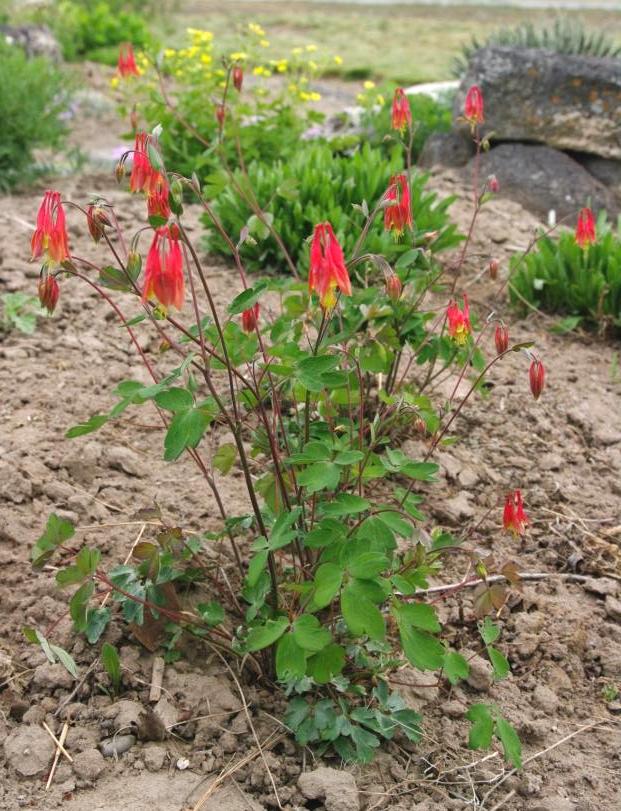Desert Columbine in the Landscape

Stephen Love, University of Idaho
Scientfic Name: Aquilegia desertorumCommon Name: Desert Columbine, Mogollon Columbine
Description: Desert columbine is an herbaceous, very long-lived perennial. The plants die back to the ground during winter. New shoots emerge early in the spring from a cluster of fleshy crowns and develop into a dense clump of attractive, divided leaves in early spring. The nodding flowers are short-spurred and dark red with yellow centers. Bloom period is fairly long, May to July, with some rebloom under good growing conditions in late summer. Unlike most other columbine species, desert columbine does not have an upright habit. The flowering stems are wiry and stick out from the foliage in random directions. This species can withstand drought conditions and is a good subject for dry shade or beds and borders in full sun.
Native Habitat: Aquilegia desertorum is native to Arizona north of Grand Canyon and around Flagstaff, and eastward into San Juan County, New Mexico. Plants grow on limestone outcroppings and ledges in xeric or moist conditions at elevations ranging from 4,000 to 8,000 feet.
Cultural Requirement
Soil: Tolerates a wide range of soils, including those with high pH and/or high in clay.
Moisture Tolerance: Thrives under a wide range of conditions, from moist to dry. Will not look as nice or flower as long under strictly xeric conditions.
Sun/Shade/Preference: Grows well and blooms adequately in full sun or in light to moderate shade.
Transplanting: Easily transplanted, both from pot to pot and from pot to garden. Plants can withstand long-term culture in pots up to one gallon size.
Propagation: Best grown from seed. Requires a fairly long (but undetermined, possibly 12 weeks) period of cold stratification to optimize germination. Even with stratification, germination can be sporadic and is sometimes low. Once emerged, seedlings are easy to handle and transplant nicely when they have 4 to 6 true leaves. Smaller plants are more difficult to handle without losses. Plants can also be propagated by rooting basal stem cuttings.
Maintenance (pruning, fertilization, deadheading, division, irrigation, etc): Aquilegia desertorum requires minimal maintenance. Remove spent flower stems to improve appearance and encourage later bloom. Apply supplemental irrigation if the leaves begin to show signs of stress. A moderate amount of nitrogen fertilizer will invigorate older plants.
Insect, disease, or other problems: Desert columbine is commonly infested by aphids, spider mites, and powdery mildew, problems that are common to most columbine species. Aphids can affect the blooms and may occasionally need control treatments with insecticidal soap or an appropriate insecticide. Spider mites and powdery mildew affect the plants in late summer as the leaves age. If these pests make the plants unattractive, it is best to remove the foliage and let new, attractive foliage grow back.
Landscape Value
Use in the Landscape: Desert columbine is a versatile plant and can be put to many uses. It can be used to bring color to areas of light shade and to accent other plants in beds, borders, and rock gardens. Desert columbine is especially effective as filler around trees and shrubs. It can also be grown in decorative pots. This plant is amenable to either formal or naturalized designs and can be incorporated almost anywhere in the landscape.
Weediness/Invasive Potential: Desert columbine is a clump-forming plant and does not spread via rhizomes or stolons. It will occasionally produce volunteer seedlings immediately around the parent plant. These are easily controlled do not represent invasive behavior.
Foliage: Foliage of desert columbine tends to be loose and open. The leaves are compound (twice divided) into groups of three leaflets. The leaves are very dark green and often show red highlights.
Flower: Wiry, convoluted, branched flower stems extend above the foliage. Flowers are short-spurred, up to 2 inches long, and nodding. Flower color is dark red with dark yellow center petals. The flowers are very attractive to hummingbirds.
Timing: May-July
Fruit: The fruit is a terminal capsule-like structure called a follicle. It is divided into five papery segments, each holding numerous oval, shiny, black seeds.
Form: Prior to bloom the form is loosely spherical. During bloom, the plant becomes somewhat randomly structured.
Texture: Moderately coarse.
Ultimate Size: Prior to bloom, the plants are 8 to 10 inches tall and with similar spread. Flowering plants are 15 to 20 inches in height and slightly wider than tall.
Rate of Growth: Desert columbine plants take some time to establish, but increase in size rapidly once new growth occurs. They seldom bloom the first year after transplanting to the garden.
Suggested Plant Partners: Plant desert columbine around many types of trees and shrubs, such as Acer grandidentatum, Pinus flexilis, Rhus glabra, Philadelphus microphyllus, and Dasiphora fruticosa. Also, a good complement to a wide range of grasses and perennials, including Deschampsia caespitosa, Sporobolus airoides, Artemisia michauxiana, Oenothera speciosa, Monarda fistulosa, and Erigeron formosissimus.
Availability: Difficult to find as potted plants. Seed can occasionally be purchased from native plant seed suppliers.
Cultivars: None.
References:

